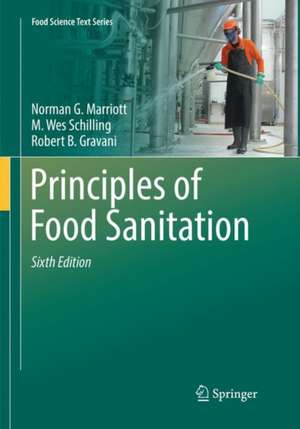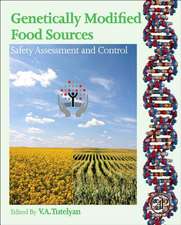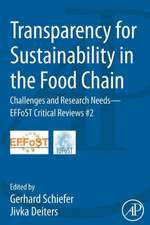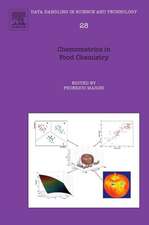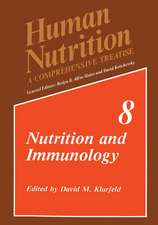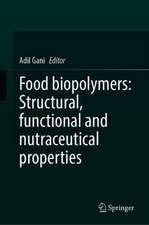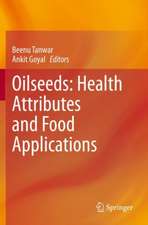Principles of Food Sanitation: Food Science Text Series
Autor Norman G. Marriott, M. Wes Schilling, Robert B. Gravanien Limba Engleză Paperback – 28 dec 2018
New in this edition:
Updated chapters on the fundamentals of food sanitation, contamination sources and hygiene, Hazard Analysis Critical Control Points, cleaning and sanitizing equipment, waste handling disposal, biosecurity, allergens, quality assurance, pest control, cleaning compound and sanitizer properties and selection criteria, hygienic construction, sanitation guidelines for food and foodservice establishments, and sanitation management principles.
| Toate formatele și edițiile | Preț | Express |
|---|---|---|
| Paperback (1) | 474.31 lei 6-8 săpt. | |
| Springer International Publishing – 28 dec 2018 | 474.31 lei 6-8 săpt. | |
| Hardback (1) | 608.23 lei 6-8 săpt. | |
| Springer International Publishing – 17 apr 2018 | 608.23 lei 6-8 săpt. |
Din seria Food Science Text Series
- 17%
 Preț: 502.95 lei
Preț: 502.95 lei - 17%
 Preț: 469.18 lei
Preț: 469.18 lei - 15%
 Preț: 549.39 lei
Preț: 549.39 lei - 20%
 Preț: 579.80 lei
Preț: 579.80 lei -
 Preț: 458.78 lei
Preț: 458.78 lei - 15%
 Preț: 566.10 lei
Preț: 566.10 lei - 13%
 Preț: 358.75 lei
Preț: 358.75 lei - 15%
 Preț: 635.75 lei
Preț: 635.75 lei -
 Preț: 396.40 lei
Preț: 396.40 lei -
 Preț: 482.23 lei
Preț: 482.23 lei -
 Preț: 392.37 lei
Preț: 392.37 lei -
 Preț: 398.35 lei
Preț: 398.35 lei - 15%
 Preț: 508.60 lei
Preț: 508.60 lei - 15%
 Preț: 508.75 lei
Preț: 508.75 lei - 15%
 Preț: 587.39 lei
Preț: 587.39 lei - 18%
 Preț: 965.83 lei
Preț: 965.83 lei -
 Preț: 393.13 lei
Preț: 393.13 lei - 15%
 Preț: 532.70 lei
Preț: 532.70 lei - 15%
 Preț: 593.26 lei
Preț: 593.26 lei - 15%
 Preț: 658.05 lei
Preț: 658.05 lei - 15%
 Preț: 600.74 lei
Preț: 600.74 lei - 18%
 Preț: 971.22 lei
Preț: 971.22 lei - 15%
 Preț: 477.74 lei
Preț: 477.74 lei - 18%
 Preț: 1010.33 lei
Preț: 1010.33 lei - 15%
 Preț: 477.74 lei
Preț: 477.74 lei - 15%
 Preț: 574.25 lei
Preț: 574.25 lei
Preț: 474.31 lei
Nou
Puncte Express: 711
Preț estimativ în valută:
90.76€ • 95.01$ • 75.10£
90.76€ • 95.01$ • 75.10£
Carte tipărită la comandă
Livrare economică 05-19 aprilie
Preluare comenzi: 021 569.72.76
Specificații
ISBN-13: 9783030097929
ISBN-10: 3030097927
Pagini: 437
Ilustrații: XXX, 437 p. 50 illus., 23 illus. in color.
Dimensiuni: 178 x 254 mm
Greutate: 0.88 kg
Ediția:Softcover reprint of the original 6th ed. 2018
Editura: Springer International Publishing
Colecția Springer
Seria Food Science Text Series
Locul publicării:Cham, Switzerland
ISBN-10: 3030097927
Pagini: 437
Ilustrații: XXX, 437 p. 50 illus., 23 illus. in color.
Dimensiuni: 178 x 254 mm
Greutate: 0.88 kg
Ediția:Softcover reprint of the original 6th ed. 2018
Editura: Springer International Publishing
Colecția Springer
Seria Food Science Text Series
Locul publicării:Cham, Switzerland
Cuprins
Chapter 1: Sanitation and the Food Industry.- Chapter 2: The Relationship of Biosecurity to Sanitation.- Chapter 3: The Relationship of Microorganisms to Sanitation.- Chapter 4: The Relationship of Allergens to Sanitation.- Chapter 5: Food Contamination Sources.- Chapter 6: Personal Hygiene and Sanitary Food Handling.- Chapter 7: The Role of HACCP in Sanitation.- Chapter 8: Quality Assurance for Sanitation.- Chapter 9: Cleaning Compounds.- Chapter 10: Sanitizers.- Chapter 11: Sanitation Equipment.- Chapter 12: Waste Product Handling.- Chapter 13: Pest Control.- Chapter 14: Sanitary Design and Construction for Food Processing.- Chapter 15: Low-Moisture Food Manufacturing and Storage Sanitation.- Chapter 16: Dairy Processing Plant Sanitation.- Chapter 17; Meat and Poultry Plant Sanitation.- Chapter 18: Seafood Plant Sanitation.- Chapter 19: Fruit and Vegetable Processing Plant Sanitation.- Chapter 20: Beverage Plant Sanitation.- Chapter 21: Foodservice Sanitation.- Chapter 22: Managementand Sanitation
Notă biografică
Norman G. Marriott is an Extension Food Scientist and Professor Emeritus in the Department of Food Science and Technology at Virginia Polytechnic Institute and State University, Blacksburg, Virginia.
M. Wes Schilling is a Professor in the Department of Food Science, Nutrition, and Health Promotion at Mississippi State University, Starkville, Mississippi.
Robert B. Gravani is Professor Emeritus in the Department of Food Science at Cornell University, Ithaca, New York.
M. Wes Schilling is a Professor in the Department of Food Science, Nutrition, and Health Promotion at Mississippi State University, Starkville, Mississippi.
Robert B. Gravani is Professor Emeritus in the Department of Food Science at Cornell University, Ithaca, New York.
Textul de pe ultima copertă
Now in its 6th Edition, this highly acclaimed textbook provides sanitation information needed to ensure hygienic practices and safe food for food industry personnel as well as students. It addresses the principles related to contamination, cleaning compounds, sanitizers, cleaning equipment. It also presents specific directions for applying these concepts to attain hygienic conditions in food processing or food preparation operations.
New in this edition:
Updated chapters on the fundamentals of food sanitation, contamination sources and hygiene, Hazard Analysis Critical Control Points, cleaning and sanitizing equipment, waste handling disposal, biosecurity, allergens, quality assurance, pest control, cleaning compound and sanitizer properties and selection criteria, hygienic construction, sanitation guidelines for food and foodservice establishments, and sanitation management principles.
Caracteristici
Acclaimed textbook and industry reference Thoroughly updated chapters Essential for food processing or food preparation operations
